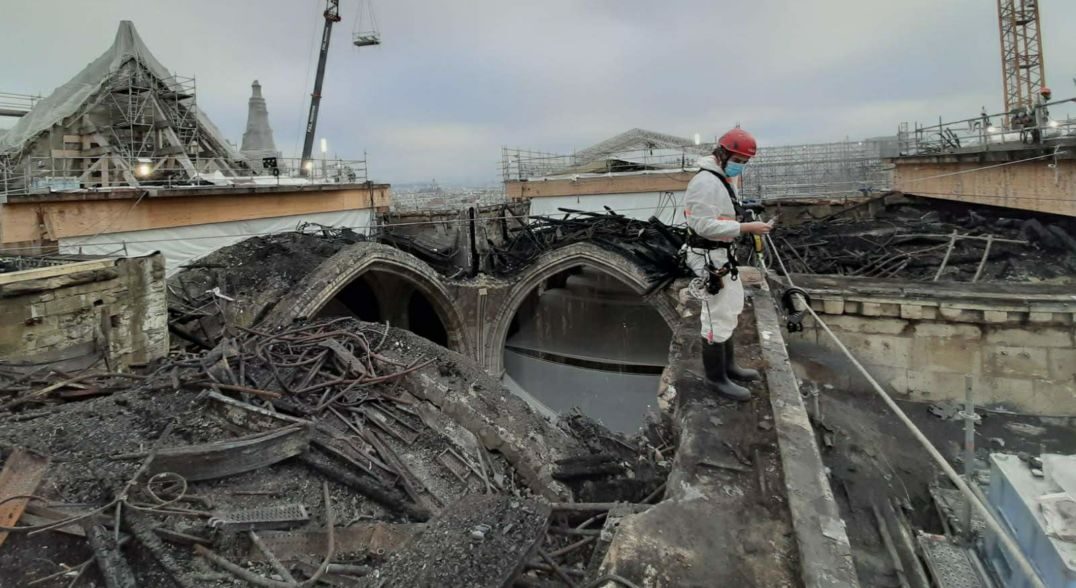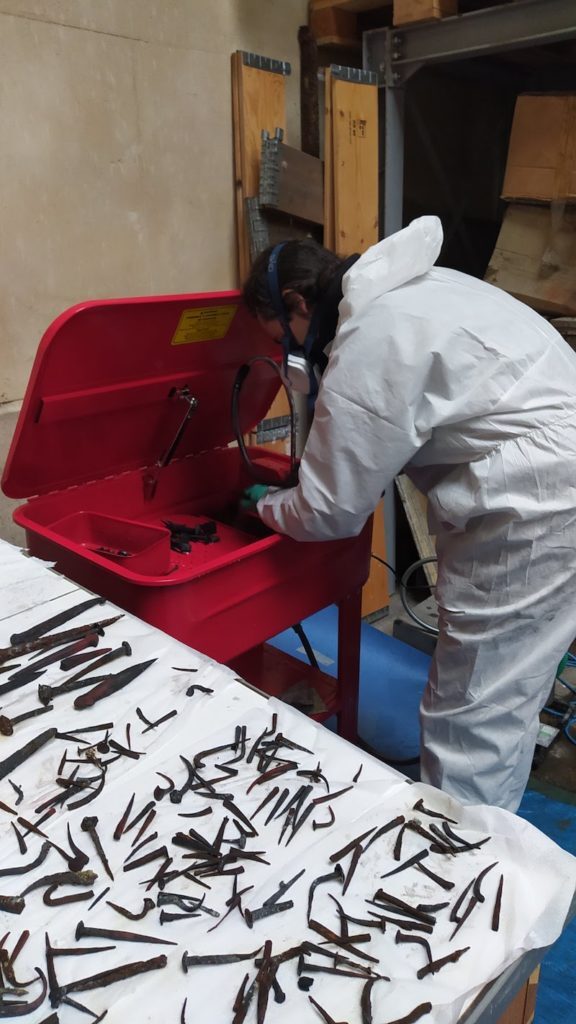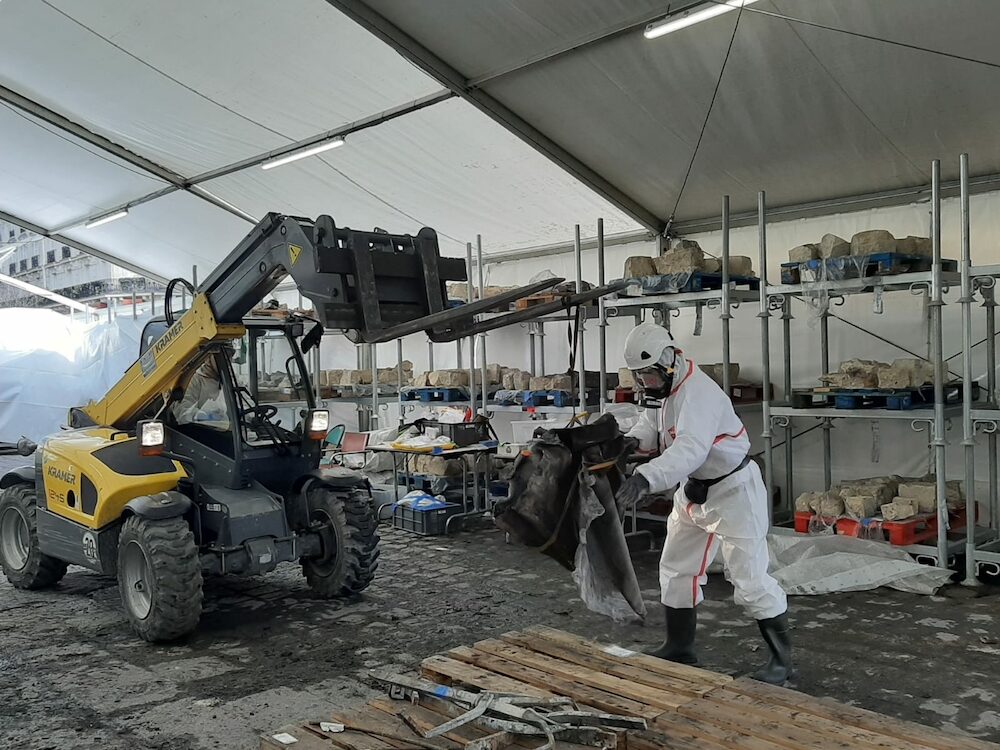
The night of April 15, 2019, brought unimaginable tragedy to Paris' iconic medieval Catholic cathedral. I was on the metro at the time, when I got a phone call from a colleague: "Notre Dame is burning." When the train crossed the Seine a few minutes later, I saw it with my own eyes, from a distance, helpless. The fire caused the cathedral spire to collapse, most of the roof was destroyed, and its upper walls were severely damaged.
The first time I could access Notre Dame was in December 2019, more than six months after the fire. I pulled on a mandatory protective suit and powered respirator to protect me from lead emissions, and was taken up to the top of the southern transept. From there, I gasped at the site of the northern great rose window through the wide hole where the spire had totally collapsed. I was speechless. The vaults were a total mess of carbonized wooden and metallic pieces.
The atmosphere was oppressive. Although I had watched the fire many times on television, only at that moment did I truly realize how devastating the blaze was and how demanding the task was before us — not just for the architects restoring the building, but also for us archaeologists brought in to study the entangled vestiges of the cathedral.
Working on Notre Dame was obvious for me from that moment. As a medieval archaeologist and historian, I have worked for 20 years studying Gothic constructions. I knew that although the upper parts of the cathedral had burnt, there was still much more to lose if we, scientists, did not step in. The day after the fire, a few colleagues and I decided to create an association to collect and preserve any and all information that we could. Our movement gathered more than 200 scientists in a couple of weeks, all willing to serve Notre Dame.

It was not long before the French National Centre for Scientific Research (CNRS) and the Ministry of Culture decided to organize and fund this research in close interaction with the architects and the public contracting authority. Several dedicated working groups were set up on "Stone," "Wood," "Glass," "Metal," "Structure," "Heritage Emotions," "Acoustics," and "Digital Data." Due to my experience in the use of metals in Gothic churches (I wrote my doctoral dissertation on the subject), I was asked to gather and coordinate the metal group, currently counting about 15 members from different institutions.
Ironically, it is actually far easier for us archaeologists to investigate the monument now than it was before the fire. Although the fire released a lot of lead, making it necessary for researchers to don protective clothing and abide by procedures to avoid lead toxicity, we no longer face the obstacles presented by floods of tourists on the site, and materials damaged by the fire are now more available for analysis. Together, we have learned a lot about the building, its materials, and the possibilities for reconstruction.
The cathedral was started in the 1160s and mostly finished by the 1260s, with many modifications, repairs, and restorations over the following centuries.
Our metal group has been focused on uncovering the "iron skeleton" of the building: armature including chains, cramps, pins, and nails used to hold up the wood and stone. We now know much of the metal dates to the time of the original construction in the 12th and early 13th centuries. We think we have just found a set of about 1,000 nails 12-cm long used in the original framework for the suspended wooden pathway, dating from the 13th century. A series of iron cramps (40-cm long iron staples) were discovered just below the beams on top of the upper walls, which were literally unreachable before the fire. Some more were unveiled in the domed tribunes and in the nave chapels using metal detectors.
Trees felled to build the cathedral hold a record in their tree rings of what the climate was like.
Some of the pieces are being examined under the microscope and are undergoing chemical and mechanical tests, along with carbon dating of trace amounts of carbon in the metal. Our studies aim to clarify how these metal components were used in the building structure, when they were installed, and also the metal's quality and where it was sourced from. This will shed some light on the choices made by the builders, along with ancient supply and trade routes. It will also help in assessing the course and impact of the fire, and the possibilities of reusing some of the old components in reconstruction.
Our investigations also focus on lead. This metal was used for roofing tiles since the earliest stages of Notre Dame's construction, to seal stones and iron armatures, and for decoration, particularly in the 19th-century spire. Hundreds of tons of lead were used in the building, yet so little is known about this metal.
Our research aims to identify the practices of craftspersons and the different sources of lead that were used (including recycled material). For example, the 13th-century roof was tiled again in the 18th and 19th centuries by recasting part of the old lead, according to the incomplete records of the building yard. Our analyses will use comparisons of the isotopic composition of medieval and 19th-century lead to add details to this picture. More than 270 lead samples have been analyzed so far, showing different construction phases in the tribunes and adding precision to former architectural studies.
Lead is also of interest to environmental scientists and health researchers: The cathedral blaze released toxic lead dust into the air in a mix of medieval and modern lead. Some researchers have been tracking its potential contribution to air pollution in Paris.
The archaeologists and dendrochronologists of the wood group do not have access to the wooden vestiges yet. The burnt timbers, polluted with lead, have been evacuated to a distant, dedicated warehouse. It will open soon for researchers.
There is much to learn from the burnt medieval framework, known as "the forest," which incorporates wood from more than 1,000 trees. Before the fire, getting permission to take samples for dating was not an easy process; only about 70 samples were dated by dendrochronologists.

The timbers can also provide information on the 12th-century climate. From about 950-1250, the North Atlantic region spanning from eastern North America to western Eurasia experienced a spell of warm weather called the Medieval Warm Period. Trees living during this period, and felled to build the cathedral, will hold a record in their tree rings of what the climate was like. While there are other records of the climate at this time, the huge number of samples now available from Notre Dame will make an unprecedented contribution to this subject of study. Understanding the details of past warm periods helps in understanding today's global warming.
Comment: So the cathedral, considered a masterpiece of engineering and art, was constructed during the Medieval Warm Period; if that's what warming can do for a civilization, then it's probably too bad that our world is entering a cooling period.
The stone group is currently investigating the masonries of the north and south transepts of the cathedral, each of which holds a stunning stained-glass rose window. Archival records have suggested that these transepts were the work of two successive masters: Jean de Chelles and Pierre de Montreuil. But our analysis of lead joints from the galleries below the rose windows suggests that they share a similar composition, and so, might have been made at the same time. The ongoing investigation of the type and shape of stones used in each transept will help determine if they were erected simultaneously.
Architects completed their first diagnosis of the cathedral's structure in December 2020, but much remains to be done. As these lines are written, the lasts vestiges of the burnt roof and spire are still being excavated and removed from the cleaned vaults, almost two years after the fire. In February of this year, some stones collapsed from the vaults due to frost. Renovation works are unlikely to begin before the end of 2021.
It is unusual to have such a combination of research and scientific skill all focused at the same time on a single monument. The result is really fascinating and fruitful. From a true disaster, Notre Dame's fire gave birth to an unprecedented scientific project and a unique opportunity for researchers and scientists working on building heritage.
Maxime L'Héritier is an associate professor in medieval history at the University of Paris 8.



Comment: See also: